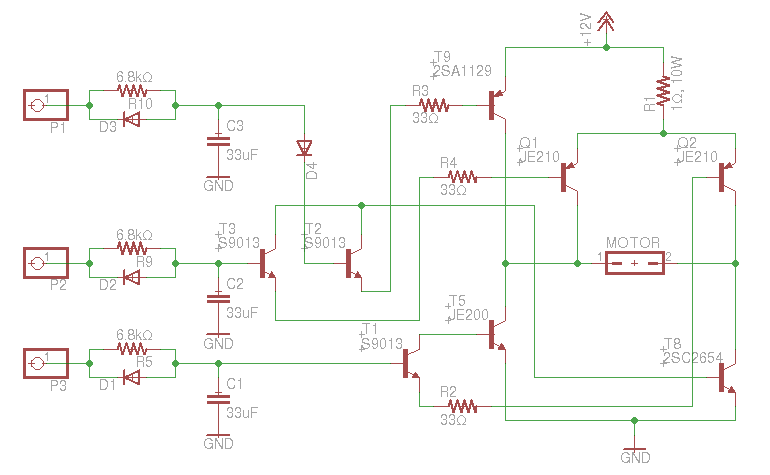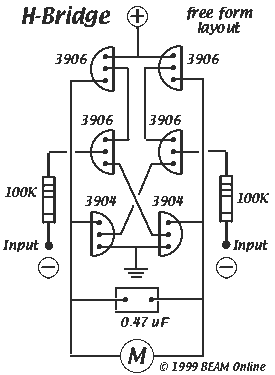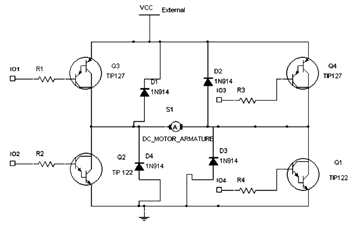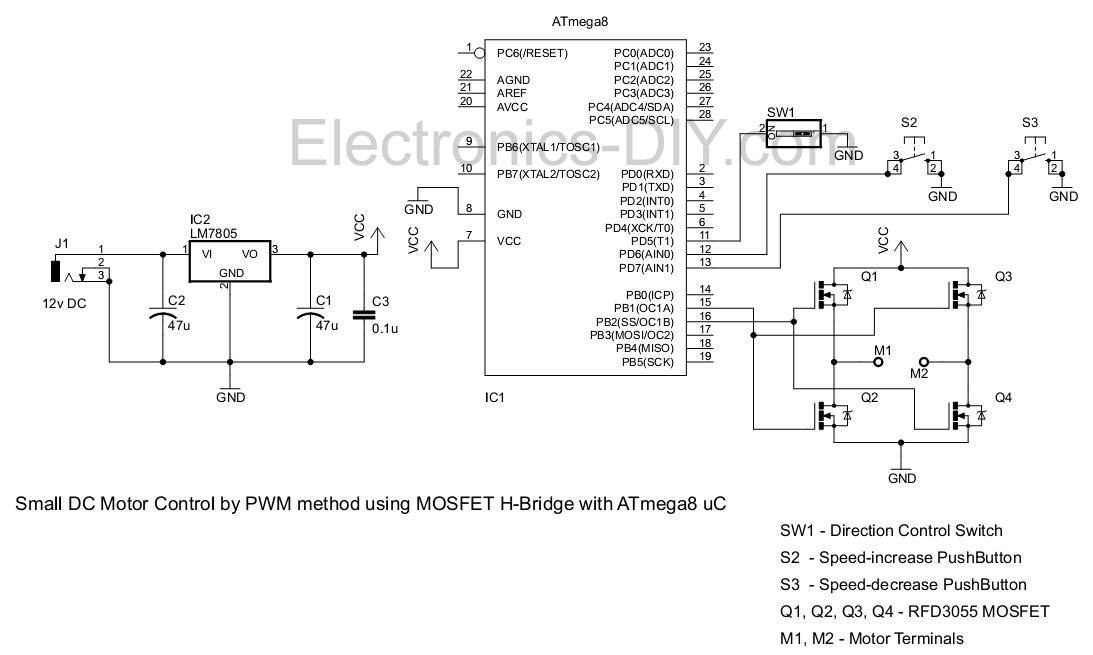
H-Bridge (A2060H) Manual
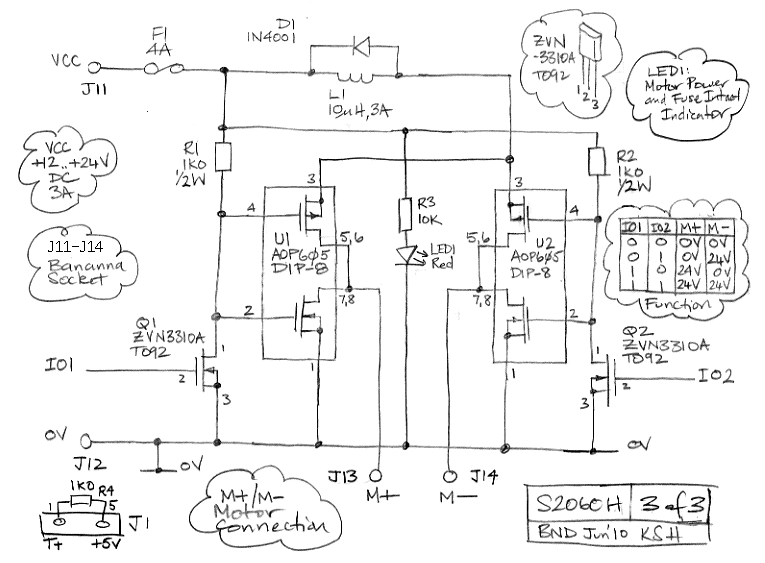
The A2060H is an H-Bridge extension for the Programmable Logic Head (A2060). Utilizing an external power supply to deliver motor current, the A2060H enables variable-speed, bi-directional control of DC motors. These motors can operate within a voltage range of 6 V to 24 V, accommodating current surges up to 4 A. A single LWDAQ command word can set the motor's direction and speed for two seconds. To maintain motor operation beyond this duration, the command must be re-transmitted before the motor halts. Two switches are provided to override the LWDAQ command, allowing the motor to run at full speed in either direction. The A2060H employs the LC4256V-10T100I programmable logic chip from Lattice Semiconductor. The circuit diagram for the H-Bridge extension is designated as A2060H_3. The latest P2060H logic code version can be found at the specified location. An application example of the A2060H is the Long Guide Tube. The A2060H functions as an LWDAQ device, drawing power for its internal logic from the LWDAQ, while requiring a separate positive power supply connected to the VCC (J11) and 0V (J12) terminals. The motor is connected to the M+ (J13) and M- (J14) terminals. Sixteen LEDs on the board indicate the command bits. The SPD6 to SPD0 bits control the rotation speed, while the DIR bit determines the direction. In firmware versions 1-7, speed and direction bits occupied DC1-DC8, but in version 8, they were relocated to avoid interference with the WAKE and LB bits. Commands can be sent to the A2060H using the Transmit button of the Diagnostic Instrument, with hexadecimal format input in the transmit entry box. The A2060H can be targeted for command transmission, with command $FF00 directing the motor at full speed in one direction and command $C000 controlling it at half-speed. The motor will stop after a few seconds unless another command is sent. Automatic command renewal is possible with the Diagnostic Instrument by entering "transmit" in the daq_actions parameter and pressing the Loop button. In specific scenarios, such as with the Long Guide Tube's rotation motor, firmware version 10 and above includes a max_speed parameter to limit maximum speed. The M+ and M- terminals connect to a DC servo motor, with either terminal set to VCC or 0V. The circuit operates with VCC between 5 V and 24 V, and the motor operates when the terminals are at different voltage levels. The firmware allows either M+ to connect to VCC while M- connects to 0V, or vice versa, enabling bi-directional motor control, but preventing an open circuit. Connecting both terminals to 0V will stop the motor quickly, as its kinetic energy generates an electromotive force, driving current through the H-Bridge circuit. The current flows through diodes in the power MOSFETs, U1 and U2. Under conditions of high torque or stalling, fuse F1 is likely to blow, and in some A2060H versions, F1 has been replaced with a wire link. The H-Bridge controls motor speed by switching VCC to one terminal for a fraction of the time while holding the other terminal at 0V. The switching period is 400 µs, with half-speed operation connecting the motor to VCC for 200 µs and to 0V for the remaining 200 µs, producing a 2.5 kHz whine in the motor coils. The DIR bit determines which motor terminal connects to VCC, establishing the rotation direction, while SPD6 to SPD0 set the duration of the VCC phase within the switching period, thus controlling speed. When all bits are set, the motor runs at full speed; when all bits are zero, the motor stops. The H-Bridge comprises two identical sides, with the first side including Q1 and U1. The Q1 transistor, along with resistor R1, converts a 3.3 V logic signal to a suitable switching voltage for the complementary power MOSFETs of U1, AOP605. When Q1 is active, the gates of the two power MOSFETs are pulled to 0V, turning on the upper MOSFET while the lower is off. M+ is connected to +24V when Q1 is active; when Q1 is inactive, M+ connects to 0V. During transitions, both transistors may conduct simultaneously, generating heat in the H-Bridge. The transition time for Q1 turning on is less than 1 µs, resulting in negligible heating, whereas the turn-off time, driven by resistor R1, takes a few microseconds, during which both power MOSFETs conduct. Inductor L1 limits the current during this phase, allowing for rapid H-Bridge switching without complex arrangements. The turn-off of Q1 takes about 8 µs, drawing an average current of around 1 A from a 24 V VCC. At a 2.5 kHz switching frequency, U1 dissipates 0.5 W, increasing its temperature by 40 °C. At 10 kHz, the temperature rise reaches 160 °C, risking internal damage and melting the plastic socket. The 4 A fuse is critical for protecting the MOSFETs against current surges. Resistor R3 and LED1 indicate when motor power is connected and when the fuse is intact. The A2060H requires R12, a 1kΩ resistor, between pins 1 and 5 of J1 to prevent frequent fuse blows. This resistor pulls up the T+ line to +5V when T+/T- are in high-impedance states during other LWDAQ measurements. Without R12, motor current-induced noise can create spikes on T+/T-', causing spurious commands that abruptly stop the motor and blow the fuse. With R12, no fuse blowing occurs unless the motor is abruptly commanded to switch from full-speed in one direction to full-speed in the opposite direction, thus necessitating software to halt the motor before reversing its direction.The A2060H is an H-Bridge extension for the Programmable Logic Head ( A2060 ). With the help of an external power supply to provide the motor current, the A2060H provides variable-speed, bi-directional drive to DC motors. The motors can operate at anywhere from 6 V to 24 V, with current surges up to 4 A. A single LWDAQ command word sets the direct ion and speed of the motor for two seconds. In order to run the motor for longer than two seconds, we re-transmit the command before the motor stops. Two switches allow us to over-ride the LWDAQ command so as to drive the motor at full speed in either direction.
The A2060C uses the LC4256V-10T100I programmable logic chip from Lattice Semiconductor. The circuit diagram for the H-Bridge extension to the A2060 circuit is A2060H_3. You will find the latest version of the P2060H logic code here. For an example of an application of the A2060H, see the Long Guide Tube. The A2060H is a LWDAQ device. It obtains power for its internal logic from the LWDAQ, but motor power must be delivered by a separate positive power supply, which we connect to the VCC (J11) and 0V (J12) terminal. The motor plugs into the M+ (J13) and M ’ (J14) terminals. The sixteen LEDs along the top of the board show the command bits. Table 1: Command Bit Allocation of the A2060H. An "X" means the command bit serves no function. The SPD6. SPD0 bits set the rotation speed. The DIR bit sets the direction. In Versions 1-7 of the firmware, the speed and direction bits occupied DC1-DC8. We moved them in Version 8 so that they would not interfere with the WAKE and LB bits. You can transmit a command to the A2060H using the Transmit button of the Diagnostic Instrument. Enter the command in hexadecimal format in the transmit entry box, make the A2060H the target of the Diagnostic Instrument and press Transmit.
Command $FF00 sends the motor in one direction at full speed, and $C000 sends it in the same direction at half-speed. The motor will stop after a couple of seconds unless you send it another movement command before it stops.
You can renew your chosen command automatically with the Diagnostic Instrument by entering transmit in the daq_actions parameter and pressing Loop (the upper one, not the lower one). Each time the instrument acquires new data, it re-sends the movement command. In some cases, such as the rotation motor of the Long Guide Tube, we want to prevent a LWDAQ command from moving the motor at full speed under any circumstances.
Firmware version 10 and higher (P2060H10 and higher) provide a max_speed parameter. We find that with this parameter set to 20, compile the code to its jedec file and re-program the logic to put the limit at roughly 12% of the maximum. The switches will still give full-speed drive, but not random commands. The M+ and M ’ terminals connect to a DC servo motor. Each can either be set at VCC or 0V. The circuit is designed to operate with VCC between 5 V and 24 V. The motor runs when the two terminals are at different levels. The A2060H firmware allows either M+ to be connected to VCC while M ’ is connected to 0V, or M ’ to be connected to VCC while M+ is connected to 0V.
Thus the motor may be driven in both directions, but it cannot be left open circuit. As soon as we connect both terminals to 0V, the motor will stop quickly. Its kinetic energy will generate an electromotive force, which will drive current through the H-Bridge circuit. The current will flow through diodes in the power mosfets, U1 and U2. At such times, or when the motor is belabored by torque to the point of stalling, fuse F1 is likely to blow.
We replaced F1 with a wire link in some versions of the A2060H. The H-Bridge varies the speed of the motor by switching VCC onto one terminal for a fraction of the time, while holding the other terminal at 0V. The switching period is 400 s. At half-speed, the motor is connected to VCC for 200 s and 0V for the remaining 200 s. This creates a 2. 5-kHz whine in the motor coils, which young people can hear better than old people. Each time the H-Bridge turns off VCC to the motor, a certain amount of energy is dissipated in the power mosfets U1 and U2.
This energy heats up the mosfets whether there is a motor connected or not. At a switching frequency of 10 kHz, the mosfets get so hot after a while that they melt their plastic sockets. At 2. 5 kHz, they are warm, but they never get hot. The DIR bit sets the terminal of the motor to which VCC will be connected. This determines the direction of rotation. The bits SPD6. SPD0 set the length of the VCC portion of the switching period, and thus determine the speed. If they are all set, the pulse is at its maximum length and voltage is the entire time. The motor runs at full speed. If the bits are all zero, the motor stops. The two sides of the H-Bridge are identical. The first side consists of Q1 and U1. The Q1 transistor in combination with resistor R1 turns a 3. 3-V logic signal into a switching voltage suitable for turning on and off the complimentary power mosfets of U1, AOP605.
When Q1 is on, the gates of the two power mosfets are brought down to 0V, so the top one is on and the bottom one is off. The M+ terminal is connected to +24V. When Q1 is off, M+ is connected to 0V. During the transition, both transistors will be on at the same time, and this is when the H-Bridge generates its own heat.
When Q1 turns on, which is when we connect VCC to M+, the transition takes place in less than 1 s and the heating is negligible. But when Q1 turns off, it is resistor R1 that pulls up the gates of the mosfets, and it does this with a time constant of a few microseconds.
During these few microseconds, the power mosfets are both conducting. The current drawn from VCC is, however, limited by inductor L1. With 24V across it, the current in L1 builds up at 2. 4 A/ s. As the current starts to increase through the conducting mosfets, L1 drops the voltage on the source of the p-channel mosfet (the upper of the two), which in turn decreases its gate-source voltage, and so tends to turn it off. Thus L1 limits the currrent in two ways, making it possible for us to switch the H-Bridge using Q1, Q2, R1, and R2, instead of a more complicated arrangement of push-pull transistors that would complete both transitions in negligible time.
The turn-off of Q1 ends up taking 8 s, during which time the average current drawn from a 24-V VCC is around 1 A. At a switching frequency of 2. 5 kHz, U1 dissipates 0. 5 W, which raises its temperature by 40 °C. At 10 kHz, the package heats up by 160 °C, at which point it starts to suffer internal damage and to melt its plastic socket.
The 4-A fuse is essential for protecting the mosfets against current surges through the motor. Resistor R3 and lamp LED1 indicate when the motor power is connected and the 4-A fuse is intact. This fuse will blow frequently if the A2060H is not equipped with R12 between pins 1 and 5 of J1. This 1K0 resistor pulls up the T+ line to +5V when T+/T ’ are high-impedance at the LWDAQ multiplexer or LWDAQ driver. If we are running the motor while simultaneously measuring position or load with another LWDAQ device, T+/T ’ will be high-impedance when these other measurements are taking place.
Without R12, motor-current induced noise will produce spikes on T+/T ’, thus generating spurious commands that stop the motor so suddenly the fuse blows. With R12, however, we observe no fuse blowing, unless we deliberately instruct the motor to go from full-speed in one direction to full speed in the other.
Therefore, our software always stops the motor before reversing its direction. 🔗 External reference
The A2060C uses the LC4256V-10T100I programmable logic chip from Lattice Semiconductor. The circuit diagram for the H-Bridge extension to the A2060 circuit is A2060H_3. You will find the latest version of the P2060H logic code here. For an example of an application of the A2060H, see the Long Guide Tube. The A2060H is a LWDAQ device. It obtains power for its internal logic from the LWDAQ, but motor power must be delivered by a separate positive power supply, which we connect to the VCC (J11) and 0V (J12) terminal. The motor plugs into the M+ (J13) and M ’ (J14) terminals. The sixteen LEDs along the top of the board show the command bits. Table 1: Command Bit Allocation of the A2060H. An "X" means the command bit serves no function. The SPD6. SPD0 bits set the rotation speed. The DIR bit sets the direction. In Versions 1-7 of the firmware, the speed and direction bits occupied DC1-DC8. We moved them in Version 8 so that they would not interfere with the WAKE and LB bits. You can transmit a command to the A2060H using the Transmit button of the Diagnostic Instrument. Enter the command in hexadecimal format in the transmit entry box, make the A2060H the target of the Diagnostic Instrument and press Transmit.
Command $FF00 sends the motor in one direction at full speed, and $C000 sends it in the same direction at half-speed. The motor will stop after a couple of seconds unless you send it another movement command before it stops.
You can renew your chosen command automatically with the Diagnostic Instrument by entering transmit in the daq_actions parameter and pressing Loop (the upper one, not the lower one). Each time the instrument acquires new data, it re-sends the movement command. In some cases, such as the rotation motor of the Long Guide Tube, we want to prevent a LWDAQ command from moving the motor at full speed under any circumstances.
Firmware version 10 and higher (P2060H10 and higher) provide a max_speed parameter. We find that with this parameter set to 20, compile the code to its jedec file and re-program the logic to put the limit at roughly 12% of the maximum. The switches will still give full-speed drive, but not random commands. The M+ and M ’ terminals connect to a DC servo motor. Each can either be set at VCC or 0V. The circuit is designed to operate with VCC between 5 V and 24 V. The motor runs when the two terminals are at different levels. The A2060H firmware allows either M+ to be connected to VCC while M ’ is connected to 0V, or M ’ to be connected to VCC while M+ is connected to 0V.
Thus the motor may be driven in both directions, but it cannot be left open circuit. As soon as we connect both terminals to 0V, the motor will stop quickly. Its kinetic energy will generate an electromotive force, which will drive current through the H-Bridge circuit. The current will flow through diodes in the power mosfets, U1 and U2. At such times, or when the motor is belabored by torque to the point of stalling, fuse F1 is likely to blow.
We replaced F1 with a wire link in some versions of the A2060H. The H-Bridge varies the speed of the motor by switching VCC onto one terminal for a fraction of the time, while holding the other terminal at 0V. The switching period is 400 s. At half-speed, the motor is connected to VCC for 200 s and 0V for the remaining 200 s. This creates a 2. 5-kHz whine in the motor coils, which young people can hear better than old people. Each time the H-Bridge turns off VCC to the motor, a certain amount of energy is dissipated in the power mosfets U1 and U2.
This energy heats up the mosfets whether there is a motor connected or not. At a switching frequency of 10 kHz, the mosfets get so hot after a while that they melt their plastic sockets. At 2. 5 kHz, they are warm, but they never get hot. The DIR bit sets the terminal of the motor to which VCC will be connected. This determines the direction of rotation. The bits SPD6. SPD0 set the length of the VCC portion of the switching period, and thus determine the speed. If they are all set, the pulse is at its maximum length and voltage is the entire time. The motor runs at full speed. If the bits are all zero, the motor stops. The two sides of the H-Bridge are identical. The first side consists of Q1 and U1. The Q1 transistor in combination with resistor R1 turns a 3. 3-V logic signal into a switching voltage suitable for turning on and off the complimentary power mosfets of U1, AOP605.
When Q1 is on, the gates of the two power mosfets are brought down to 0V, so the top one is on and the bottom one is off. The M+ terminal is connected to +24V. When Q1 is off, M+ is connected to 0V. During the transition, both transistors will be on at the same time, and this is when the H-Bridge generates its own heat.
When Q1 turns on, which is when we connect VCC to M+, the transition takes place in less than 1 s and the heating is negligible. But when Q1 turns off, it is resistor R1 that pulls up the gates of the mosfets, and it does this with a time constant of a few microseconds.
During these few microseconds, the power mosfets are both conducting. The current drawn from VCC is, however, limited by inductor L1. With 24V across it, the current in L1 builds up at 2. 4 A/ s. As the current starts to increase through the conducting mosfets, L1 drops the voltage on the source of the p-channel mosfet (the upper of the two), which in turn decreases its gate-source voltage, and so tends to turn it off. Thus L1 limits the currrent in two ways, making it possible for us to switch the H-Bridge using Q1, Q2, R1, and R2, instead of a more complicated arrangement of push-pull transistors that would complete both transitions in negligible time.
The turn-off of Q1 ends up taking 8 s, during which time the average current drawn from a 24-V VCC is around 1 A. At a switching frequency of 2. 5 kHz, U1 dissipates 0. 5 W, which raises its temperature by 40 °C. At 10 kHz, the package heats up by 160 °C, at which point it starts to suffer internal damage and to melt its plastic socket.
The 4-A fuse is essential for protecting the mosfets against current surges through the motor. Resistor R3 and lamp LED1 indicate when the motor power is connected and the 4-A fuse is intact. This fuse will blow frequently if the A2060H is not equipped with R12 between pins 1 and 5 of J1. This 1K0 resistor pulls up the T+ line to +5V when T+/T ’ are high-impedance at the LWDAQ multiplexer or LWDAQ driver. If we are running the motor while simultaneously measuring position or load with another LWDAQ device, T+/T ’ will be high-impedance when these other measurements are taking place.
Without R12, motor-current induced noise will produce spikes on T+/T ’, thus generating spurious commands that stop the motor so suddenly the fuse blows. With R12, however, we observe no fuse blowing, unless we deliberately instruct the motor to go from full-speed in one direction to full speed in the other.
Therefore, our software always stops the motor before reversing its direction. 🔗 External reference
Warning: include(partials/cookie-banner.php): Failed to open stream: Permission denied in /var/www/html/nextgr/view-circuit.php on line 713
Warning: include(): Failed opening 'partials/cookie-banner.php' for inclusion (include_path='.:/usr/share/php') in /var/www/html/nextgr/view-circuit.php on line 713
